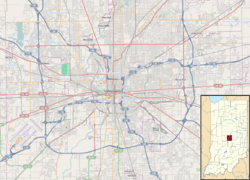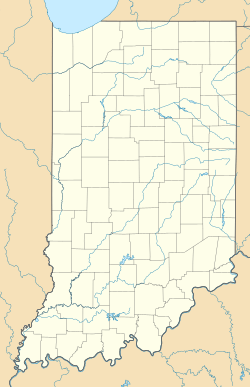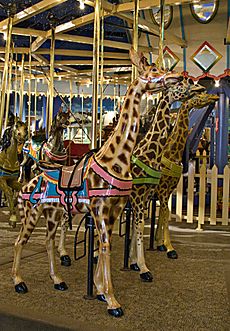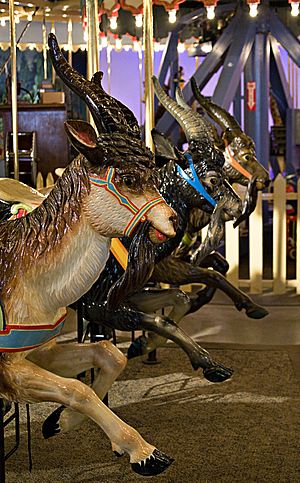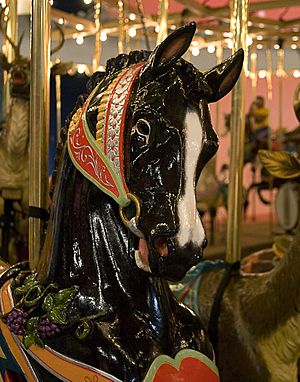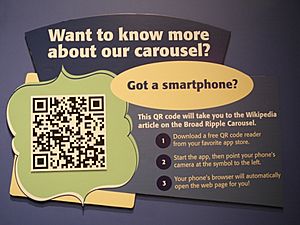Broad Ripple Park Carousel facts for kids
|
Broad Ripple Park Carousel
|
|
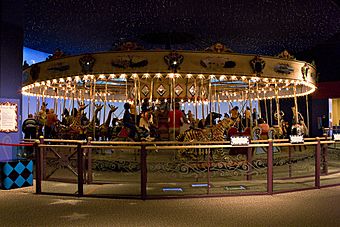
The restored carousel in The Children's Museum of Indianapolis
|
|
| Location | 30th and Meridian Streets, Indianapolis, Indiana, United States |
|---|---|
| Built | 1917 |
| Architect | William F. Mangels; Gustav Dentzel |
| NRHP reference No. | 87000839 |
Quick facts for kids Significant dates |
|
| Added to NRHP | February 27, 1987 |
| Designated NHL | February 27, 1987 |
The Broad Ripple Park Carousel is a very old and special carousel located at The Children's Museum of Indianapolis. It was first set up in 1917 at an amusement park near the White River in Indianapolis, Indiana. It stayed there until the building holding it fell down in 1956.
Even though the carousel's spinning parts were ruined, the animal carvings were mostly safe. The park owners, the Indianapolis Department of Parks and Recreation, put them into storage. These animals were carved by the Dentzel Carousel Company before 1900. The carousel itself was put together by the William F. Mangels carousel company, which also made the engine that powered the ride.
The Children's Museum of Indianapolis started collecting the carved animals in 1965. By 1973, they had almost all of them. At first, the museum thought about selling some animals to pay for restoring others. But the museum's director, Mildred Compton, was convinced by carousel fans to restore all the animals and make the carousel work again.
The restoration of the carved animals began in 1966. The entire carousel was finally finished and working again in 1977. The museum's new building wasn't designed for such a big display. So, they had to change the plans to fit the carousel on the fifth floor. A special Wurlitzer band organ from 1919 was also added. The restored carousel is about 42 feet (13 meters) wide. It has 42 animals, including horses, goats, giraffes, deer, a lion, and a tiger. In 1987, it was named a National Historic Landmark.
Contents
Carousel History
Early Days at White City Park
The Broad Ripple Park Carousel was put in place in 1917. It was part of an amusement park called White City Amusement Park. This park opened in 1906 next to the White River in Broad Ripple Village. In 1908, a fire damaged most of the park. It closed for three years.
Later, the Union Traction Company bought the park. They fixed it up and ran it for eleven years. The carousel was installed during this time. In 1922, the park was sold again and renamed Broad Ripple Park. It changed owners a few more times. In 1945, the Indianapolis Board of Parks Commission bought the park. They turned it into a general park and sold off most of the rides. The carousel was one of the few rides that stayed in Indianapolis.
How the Carousel Was Built
William Hubbs ordered the carousel for White City Amusement Park in 1917. It was built using a Mangels-Illions machine. The animals themselves were carved by the Dentzel carousel company in Philadelphia, Pennsylvania. These carvings were made sometime before 1900. The William F. Mangels carousel company then put the whole ride together in 1917.
No one knows much about the animals before they became part of this carousel in 1917. Some newspaper stories in the 1960s said the animals came from Germany. But later research showed they were made by the Dentzel company in the United States. The carousel also had beautiful oil paintings on its canopy (the roof over the animals).
Some of the animals were changed to fit the Mangels machine. For example, some animals that were carved to stand still were changed so they could move up and down, becoming "jumpers."
Life at the Park
From 1917 to 1938, the carousel was in a building near the White City park pool. In 1938, it was moved to a children's play area. It was put inside an open pavilion with a domed roof. People paid to ride the carousel, and one person, William Hubbs, ran it for almost 10 years.
The park district took over the park in 1945. The carousel stayed in the same spot for 38 years. By 1955, the equipment was getting old. The park tried to paint over the old oil paintings on the canopy. But the Indianapolis Art League stopped them. They offered to restore the original paintings instead.
In 1956, the pavilion holding the carousel fell down. This destroyed the machine parts that made the carousel spin and the arms that held the animals. The park district threw away the broken parts but saved the animals. In 1961, some of the giraffes and other animals were used in a Christmas display.
Discussions began about giving the animals to the Indianapolis Zoological Society. The zoo wanted them for its children's zoo. In 1962, it was reported that the animals would be given to the main zoo. The zoo president said the animals were "bigger and more realistically colored" than newer ones.
Moving to the Museum
In 1965, The Children's Museum of Indianapolis got two horses from the carousel. Mildred Compton, the museum director, had seen the carousel before. She wanted to get all the surviving animals. But the park district only wanted to give away two at first. They were using five or six animals for their yearly Christmas displays.
By September 1966, the two horses were ready for display at the museum's entrance. Museum volunteers cleaned off old paint and restored them. Mildred Compton even got real horse tails from a slaughterhouse to replace the missing ones.
In 1969, the museum got most of the other animals. They had to search for them in a storage building. Besides many horses, they found two more giraffes, a lion, and a tiger. Experts confirmed that the animals were carved by the Dentzel company in the United States.
The museum first planned to sell some animals to help pay for things. But Mildred Compton learned that they should restore all of them and make the carousel work again. This meant changing the plans for the museum's new building. Columns had to be removed to make space for the carousel on the fifth floor.
The museum also looked for missing animals. Old photos showed there were three deer or stags that hadn't been found. Two horses were also missing. The museum asked local newspapers for help. In December 1973, an anonymous tip led them to the deer. They were being used in a Christmas show. Mildred Compton was able to get them for the museum.
Bringing it Back to Life
The mechanical parts of the carousel were put together on the fifth floor in November 1975. A Wurlitzer carousel organ from an amusement park in San Francisco was added. This organ was fixed up in 1976.
An artist created new outside panels for the carousel. These panels looked like those from carousels around the time of World War I. The carvings on the panels were made by other artists. The mirrors were made by an Indianapolis glass company.
The animals were restored between 1975 and 1977 by Bill and Caroline Von Stein. They had never restored carousel animals before. The animals were in bad shape, so they didn't try to restore them to their original paint. Instead, they used their own ideas for colors and decorations. The museum only asked for natural-looking colors and no super shiny paint.
Recent Changes and Recognition
The carousel originally used a belt-driven engine. But after the first restoration, it was changed to a fluid-driven system. A pavilion was built over the carousel to help manage crowds. A ticket booth was also added. The animals are regularly removed for cleaning and touch-ups in the museum's workshops.
The carousel was named a National Historic Landmark on February 27, 1987. In 2008, its condition was called "satisfactory." It is one of the biggest items on display at the museum. Visitors can even ride it!
QRpedia and Learning
The carousel has a special QR code as part of the museum's QRpedia project. If you scan the code with a phone or tablet, it will take you to the Wikipedia article about the carousel. It will even try to show you the article in your device's language!
Carousel Animals and Design
The Broad Ripple Park Carousel is one of the three oldest surviving Dentzel "menagerie" carousels. A menagerie carousel has many different kinds of animals, not just horses.
Out of its 42 wood-carved animals:
- 31 are horses (14 standing still, 17 jumping up and down).
- There are also three goats, three giraffes, three deer, one lion, and one tiger.
The single lion and tiger are common for carousels made by Dentzel. The three giraffes are also typical. This is because Gustav Dentzel, who founded the company, loved giraffes. So, all his carousels included at least one row of them.
The animals are placed in three circles around the center. Jumping horses are usually next to stationary (still) animals. There are 18 jumping animals, which is typical for a Mangels-Illions carousel. Only one of the jumping horses is not original; it was replaced with another Dentzel horse in 1975. The animals on the outside circle were decorated with jewels at the amusement park, so the museum restored them with jewels too.
The carousel machine is about 40 feet (12 meters) wide. The whole carousel, including the animals, is about 42 feet (13 meters) wide. The organ, a 1919 Wurlitzer model #146-B, was made specifically for carousels.
See also
 In Spanish: Carrusel de Broad Ripple Park para niños
In Spanish: Carrusel de Broad Ripple Park para niños


